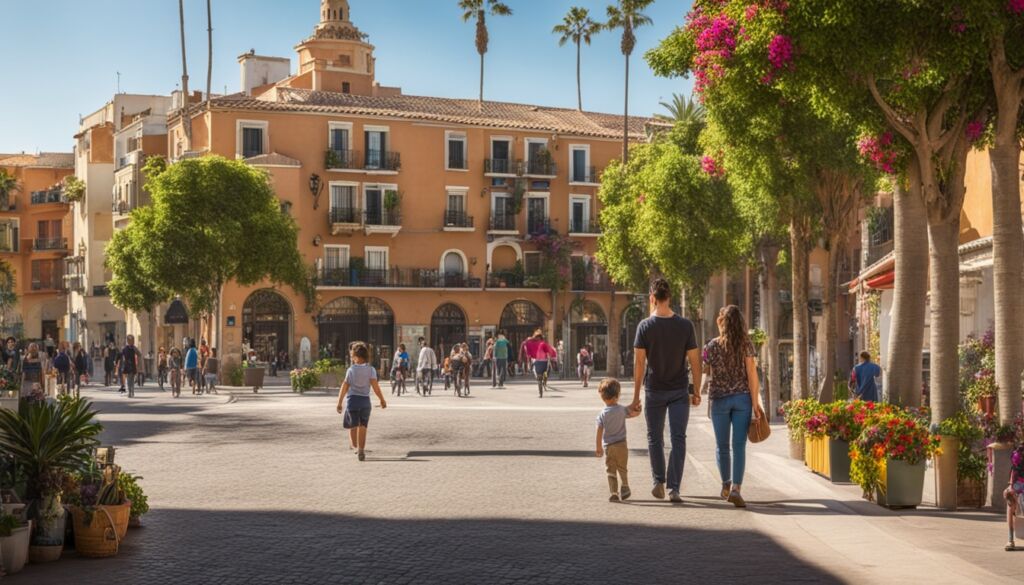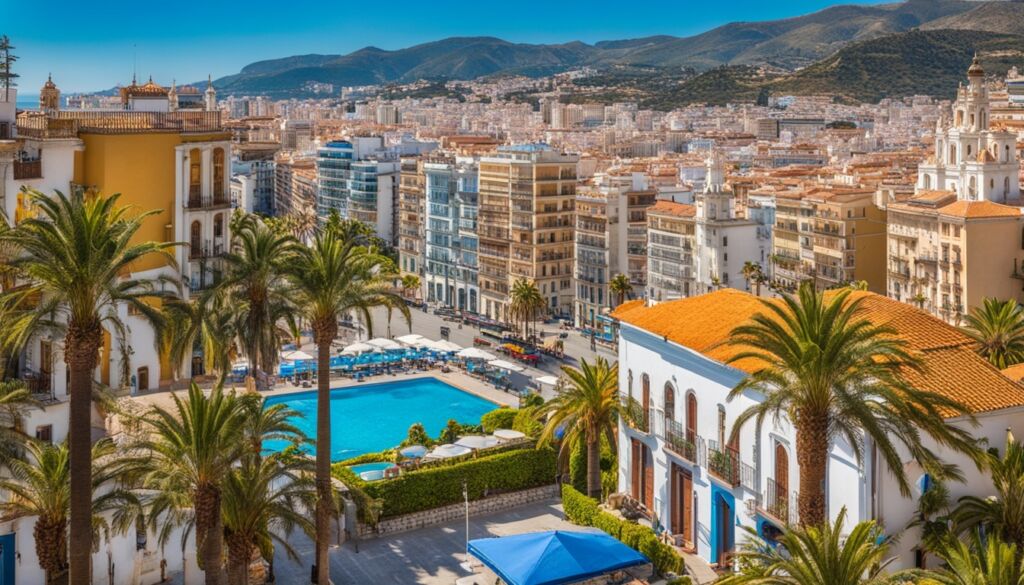Spain is perfect for a second home or to live in another country. It has a warm climate and lower rents. More than 10% of its people come from other places, adding to its charm.
It’s easy to live in Spain. Cities like Zaragoza offer help for those who speak English. From Barcelona’s excitement to Madrid’s energy and Valencia’s family feel, each place has its special style. Living in Spain is safe and simple, with easy ways to get around.
Key Takeaways
- Spain’s cities mix history, culture, and beauty, great for living or visiting.
- The expat community is big, over 10% of Spain’s population.
- Barcelona and Madrid are great for lively city living.
- Valencia is known for being family-friendly and affordable.
- Málaga offers a calm lifestyle with great weather and food.
Barcelona: The Urban Jungle Meets Sandy Beach
Barcelona is a cool mix of city and beach. It has ancient charm and modern vibes. With lots of sun, it’s perfect for beach lovers. From April, the beaches get even better. You’ll find bars and places to rent equipment. The city changed a lot after 1992, making old industrial spots into great beaches. Mar Bella and Nova Mar Bella are top for their clean and full amenities. The Sant Sebastía beach is for those who like to be free. If you prefer quiet, head to the northern beaches.
Cost of Living
Barcelona is one of Spain’s priciest cities. Be smart with money, especially for a place to live. Renting an apartment costs about €1,550 a month. But, you can find private rooms for €633. Prices change a lot based on the area. Life is good here, with lots of Catalan culture to check out. Many think it’s worth the cost.
Expat Community
Barcelona’s expat scene is lively, with people from 179 countries. It’s a mix of young pros, business owners, and people who work online. The city’s areas offer something for everyone. It’s easy to meet people and make friends here. Barcelona has a lot of events and groups for newbies. This helps them get to know the local life.
Madrid: The Best City in Spain for a Dynamic Life
Living in Madrid is full of life and action. This city mixes old with new. There are parks, a great culture, and you’re close to travel everywhere. As the capital of Spain, Madrid is well-connected all over the world.
Overview
Over 3.4 million people live in Madrid. There are over 1 million people from other countries. This makes up about 29% of the population. The city is known for its lively nightlife that starts late and goes on till morning.
It’s a top place for studying too. Madrid has more international students than any other Spanish city.
You can explore a lot of history and art in Madrid. From the Royal Palace to the Prado Museum, the city is rich in culture.
Cost of Living
Madrid is the most expensive city in Spain. Each month, you’ll spend around €720 without rent. If you add rent, it goes up to about €1,580.
Even though living here is pricey, you also get the highest salaries in Spain. The average salary is €3,190 per month. But, about half of that money might go towards rent.
| Cost Comparison | Madrid | Smaller Cities |
|---|---|---|
| Monthly Expenses (excluding rent) | €720 | €650 |
| Average Salary | €3,190 | Lower than Madrid |
| Rent as % of Income | 52% | Varies |
Job Opportunities
Madrid is a key place for jobs in Europe. It’s great for people who can speak two languages and for those who are creative.
The city is home to many companies. This includes 40% of companies that work internationally. Salaries are higher than other cities in Spain. But they may not match those in some big European cities.
Madrid is also becoming a hot spot for technology companies. It’s growing as a place for new businesses. Here, there’s a big focus on new ideas and making progress.
Valencia: Best for Families and Affordable Living

Valencia mixes city life with peaceful surroundings. It’s great for families in Spain. Many people, including those from other countries, love living here.
Family-Friendly Environment
Valencia is known for its warm feel, top-notch schools, and community spirit. Turia Gardens is a huge green area for fun and games. More than 100,000 foreigners live here, fitting in easily.
Cost of Living
Valencia won’t break your budget. It costs about €657 a month to live without rent. For a family home, expect to pay around €1,400 monthly. Or €375 for a room in a shared place.
Groceries for a month cost €400 – €700 for a family of four. Eating out at a decent place is about €60 – €120 for four. A bus pass is just €50 each month.
Gastronomy
Valencia is famous for paella and a mix of local and global dishes. You can eat from market stalls to fancy spots. The Las Fallas festival also draws people from around the world.
| Expense Category | Average Cost (€) |
|---|---|
| Monthly Cost of Living (excluding rent) | €657 |
| Apartment Rent (per month) | €1,400 |
| Private Room in Shared Accommodation | €375 |
| Monthly Grocery Bill (Family of 4) | €400-€700 |
| Dining Out for Four (mid-range) | €60-€120 |
| Monthly Public Transport Pass | €50 |
Málaga: The Charm of Southern Spain

Málaga shines with beauty, history, and modern life. It’s not far from Madrid and Seville. This coast offers beautiful beaches and a sunny, laid-back lifestyle. It’s perfect for students, families, and those who’ve retired.
Overview
Málaga is famous for its lively culture. It has lots of museums, pretty Moorish buildings, and fun festivals. Here, you can see the Alcazaba and a Roman theater. The food is all about Spanish classics like tapas, fresh fish, and local wine. The beaches and the historic places make Málaga truly special for everyone who visits.
Cost of Living
Living in Málaga is surprisingly affordable. Rent is cheaper than in other coastal cities, at about €780 a month. This lets you live well without spending too much. It’s a great spot for enjoying Southern Spain without a big budget.
Activities and Attractions
Málaga is full of things to do and see. Its good transportation makes it easy to visit. You can easily travel to places like Marbella, Granada, and more. The city itself is lively, with its pedestrian streets, shops, and bars. There’s always something to do or explore.
Conclusion
Spain is a mix of lively cities, each with its special way of life. You might be drawn to Madrid’s busy streets or Barcelona’s modern vibe. For a mix of city and beach life, Barcelona really shines with its beautiful shorelines and stylish features.
In Madrid, the party never stops with its vibrant nightlife and amazing museums like Museo del Prado. It’s a city full of excitement and culture. For families, Valencia is the spot with its low costs, friendly atmosphere, and famous paella.
Málaga invites those who love the sun and culture. It blends stunning beaches with a rich history. Every city in Spain offers something different, from study and fun nights to peaceful beaches. Spain truly has a city for everyone, whether you’re young, working, or enjoying retirement. With this guide, finding your dream Spanish city is easier than ever.










